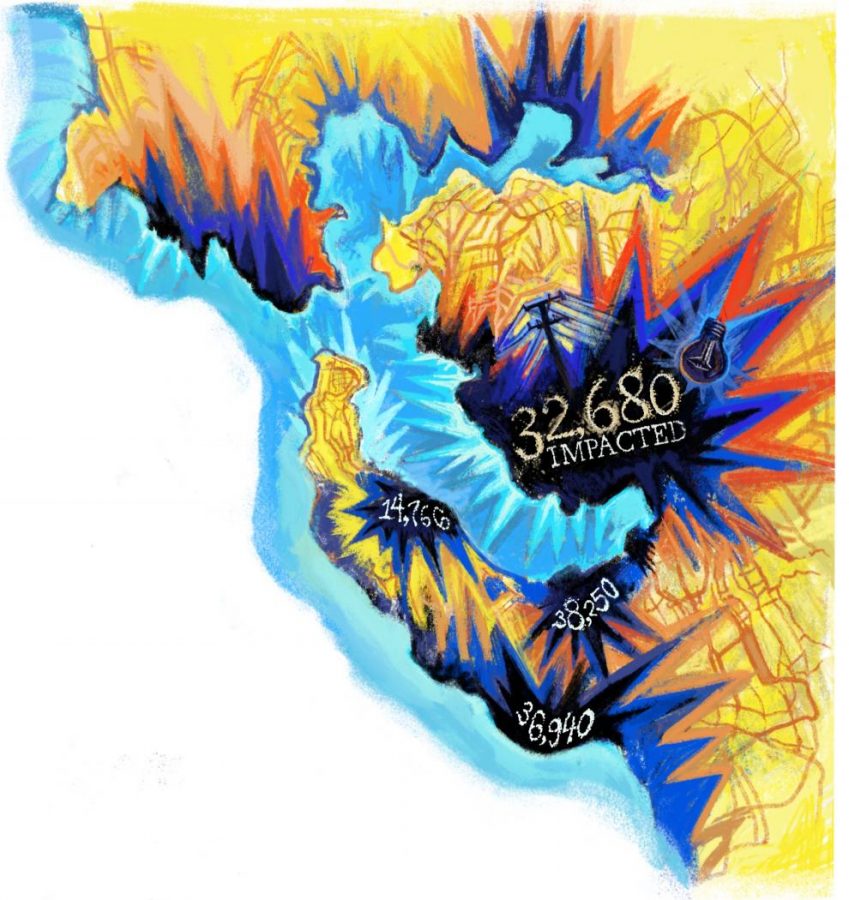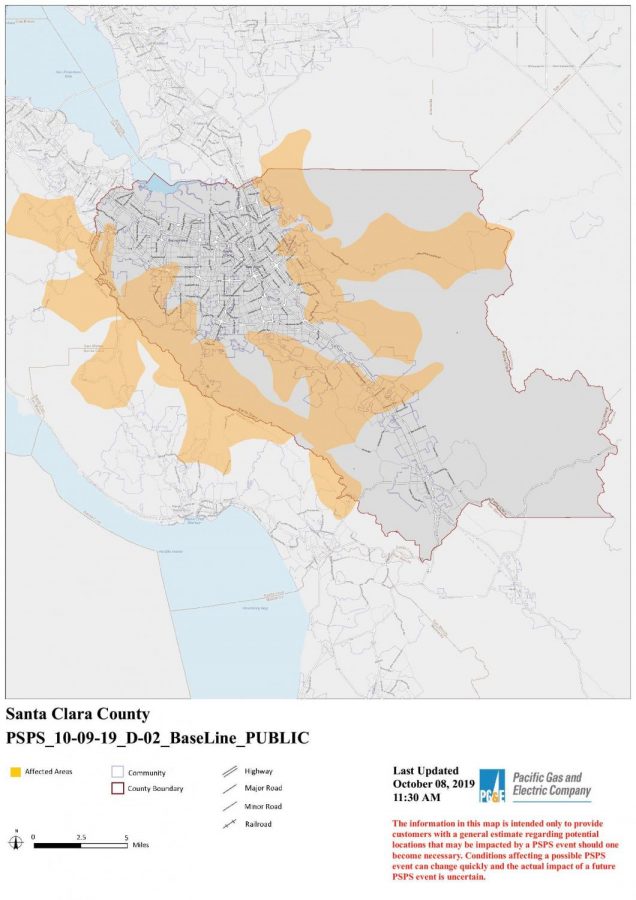Update: Bay Area electricity scheduled to return after second phase of PG&E outage shuts off power to some upper school students, faculty
A map of the Bay Area during the public safety power shutoff, which first hit the Santa Clara, Alameda, San Mateo and Santa Cruz counties Wednesday night, according to data released on Thursday by Pacific Gas and Electric Company.
This is a developing story. Check Harker Aquila for future updates.
After the conclusion of a hazardous wind event, Pacific Gas and Electric Company (PG&E) issued an “all clear” yesterday evening and has begun restoring power to customers across the Bay Area and the rest of northern California, bringing an end to this week’s public safety power shutoff.
PG&E officials announced that as of 5 p.m. yesterday, the Santa Clara, Alameda, San Mateo and Santa Cruz counties have been cleared for the restoration process, and the utility plans to begin safety inspections of power lines before fully restoring power.
On Wednesday evening, some upper school students and faculty experienced the effects of the shutoff, which cut off electricity to 122,636 Bay Area customers in total, according to PG&E’s estimates. None of the four Harker campuses were affected by the shutoff.
As of yesterday evening, 31 percent of PG&E’s impacted customers have had their power restored. Customers who were impacted by the shutoff will not be billed for the time of the shutoff.
In a press conference yesterday evening, PG&E’s Chief Customer Officer Laurie Giammona announced that there will not be any more planned outages in the near future, which means that any customers who were projected to experience an outage will not be losing electricity.
At the same conference, PG&E CEO Bill Johnson stated that as PG&E will continue to improve its approach to wildfire prevention, power shutoffs may become a more prevalent option to prevent fires in dry, windy seasons.
“This is not the future any of us want to live in. Our goal over time is to reduce wildfire risk further across the system, to shut off power less frequently and to further minimize the impact of shutoffs,” Johnson said. “Given the risk to public safety and the desire to have zero spark during conditions like the ones we’ve had over the last several days, we are very likely to have to make this kind of decision again in the future.”
Earlier in the week, warnings of dry, gusty wind conditions prompted PG&E to take precautionary measures against heightened fire risks. The Bay Area outage, which was scheduled to begin in the Santa Clara, Alameda, San Mateo and Santa Cruz counties at 8 p.m. on Wednesday night, was a part of the second phase of the utility’s “public safety power shutoff,” an intentional outage designed to prevent widespread wildfires caused by wind damage to power lines.
According to Sumeet Singh, the vice president of PG&E’s Community Wildfire Safety Program, which headed this power shutoff measure, 21 out of the 35 counties affected by the shutoff experienced winds between 45 mph and 77 mph, with winds in the Santa Cruz County reaching a high of 54 mph. The National Weather Service states that winds above 40 mph can potentially cause significant damage.
Throughout the execution of this public safety measure, PG&E has received criticism for its failure to effectively communicate accurate, updated information to its customers regarding the power shutoff. On Wednesday night, the utility’s website crashed due to a flood of traffic, even after adding capacity in preparation of the shutoff, and maps released of the impacted areas often proved to be inaccurate or vague.
“Simply, we were not adequately prepared to support the operational event,” Johnson said in the press conference.
Impacted customers were particularly frustrated with the uncertainty regarding the duration of shutoff, which PG&E only vaguely warned “could last longer than 48 hours.” The ambiguity led many customers to stock up on emergency supplies, depleting stores of water, food and other necessities earlier this week.
For instance, upper school English teacher Beverley Manning began preparing for a potential shutoff on Monday, when she first heard about the measure. Because she lives in a rural area of Santa Cruz and relies on electricity to pump water for her and her animals, Manning’s primary concern was her water supply, and she had filled as many containers as she could with water before Wednesday night, when her power went out at around 11:15 p.m.
“I understand, on the one hand, to help prevent wildfires, but on the other hand, I have a lot of issues with PG&E’s neglect to do what it should have been doing all these years, which is taking care of its power lines, trimming the vegetation around power lines and just the maintenance and routine work it should have been doing,” Manning said. “I have no problem with the power going out as a precautionary measure, but it’s the time duration involved, the uncertainty of when that’s going to be restored — that’s the most frustrating.”
Students living around the bay were also subject to the shutoff. Emma Li (12) was already asleep when, sometime around midnight on Wednesday, the power went out at her house, which is located near Rancho San Antonio, but when she woke up, she found that her house was cold and her lights were not turning on.
“I had to arrive to school early because all my appliances weren’t charged, like my laptop, my phone, and then I just charged them at school,” she said. “But I wouldn’t say it affected me too much because I finished my homework by twelve, and I fell asleep, too.”
Her family had made some preparations for the shutoff, having been warned in advance that the power might be shut off at around 8 p.m. on Wednesday, and they had showered early and brought out a portable stove in case the gas was also shut off. Emma herself was planning to go to the library to do her homework if the power went out early. Her power was restored on Thursday at noon.
Even though Emma did not experience heavy impacts from the shutoff, she still acknowledges the effects that it has had on others around the Bay Area, questioning the efficacy of PG&E’s approach to wildfire prevention.
“Does that mean that they’re going to turn off everyone’s power every time they think there’s a wildfire? I think there should be some other safety measures that affects less people,” she said. “If they keep doing this, then it’s definitely going to impact the lives of a lot of people.”

An example of a public safety alert received by customers in regions that were expected to be affected by the public safety power shutoff.
Even though the upper school campus was not directly affected by PG&E’s fire precautions, the school has taken its own safety measures to prepare for California’s fire season. In the wake of hazardous smoke events in 2018 and in 2017 caused by widespread wildfires in northern California, the upper school purchased PurpleAir air quality monitors over the summer and has begun testing the devices, which are expected to be more accurate than generalized weather reports.
“We invested in the technology to become part of the network to allow us to make decisions about what level of response we need to undertake in the event of damage to air quality,” Assistant Head of Student Affairs Greg Lawson said. “We’ve established a protocol for response on each and every campus based on the air quality index that occurs.”
In the case of a future on-campus power outage, Lawson says that classes will likely continue in “natural lighting” and “without technology,” although after school programs and other activities may be cancelled. The upper school also has analog fax machines that can facilitate limited phone community without electricity, and the emergency communication network is located off-site.
While PG&E workers are conducting safety inspections, the utility will continue keeping drop-in centers open in each affected county, which will contain restrooms, charging stations, bottled water and seating for up to 100 people. The locations of these centers, along with more information on affected counties, can be found at their website, which has been restored.

Kathy Fang (12) is the editor-in-chief of Harker Aquila. This is her fourth year on staff. From covering local marches and protests to initiating Harker...

Michelle Liu (12) is the co-editor-in-chief of The Winged Post. She joined the journalism program in her sophomore year as a reporter and became the Winged...


















![“[Building nerf blasters] became this outlet of creativity for me that hasn't been matched by anything else. The process [of] making a build complete to your desire is such a painstakingly difficult process, but I've had to learn from [the skills needed from] soldering to proper painting. There's so many different options for everything, if you think about it, it exists. The best part is [that] if it doesn't exist, you can build it yourself," Ishaan Parate said.](https://harkeraquila.com/wp-content/uploads/2022/08/DSC_8149-900x604.jpg)




![“When I came into high school, I was ready to be a follower. But DECA was a game changer for me. It helped me overcome my fear of public speaking, and it's played such a major role in who I've become today. To be able to successfully lead a chapter of 150 students, an officer team and be one of the upperclassmen I once really admired is something I'm [really] proud of,” Anvitha Tummala ('21) said.](https://harkeraquila.com/wp-content/uploads/2021/07/Screen-Shot-2021-07-25-at-9.50.05-AM-900x594.png)







![“I think getting up in the morning and having a sense of purpose [is exciting]. I think without a certain amount of drive, life is kind of obsolete and mundane, and I think having that every single day is what makes each day unique and kind of makes life exciting,” Neymika Jain (12) said.](https://harkeraquila.com/wp-content/uploads/2017/06/Screen-Shot-2017-06-03-at-4.54.16-PM.png)








![“My slogan is ‘slow feet, don’t eat, and I’m hungry.’ You need to run fast to get where you are–you aren't going to get those championships if you aren't fast,” Angel Cervantes (12) said. “I want to do well in school on my tests and in track and win championships for my team. I live by that, [and] I can do that anywhere: in the classroom or on the field.”](https://harkeraquila.com/wp-content/uploads/2018/06/DSC5146-900x601.jpg)
![“[Volleyball has] taught me how to fall correctly, and another thing it taught is that you don’t have to be the best at something to be good at it. If you just hit the ball in a smart way, then it still scores points and you’re good at it. You could be a background player and still make a much bigger impact on the team than you would think,” Anya Gert (’20) said.](https://harkeraquila.com/wp-content/uploads/2020/06/AnnaGert_JinTuan_HoHPhotoEdited-600x900.jpeg)

![“I'm not nearly there yet, but [my confidence has] definitely been getting better since I was pretty shy and timid coming into Harker my freshman year. I know that there's a lot of people that are really confident in what they do, and I really admire them. Everyone's so driven and that has really pushed me to kind of try to find my own place in high school and be more confident,” Alyssa Huang (’20) said.](https://harkeraquila.com/wp-content/uploads/2020/06/AlyssaHuang_EmilyChen_HoHPhoto-900x749.jpeg)




